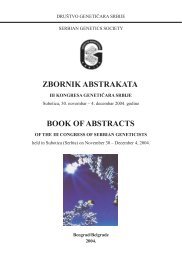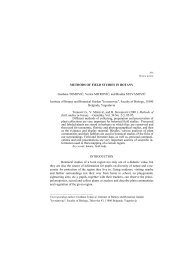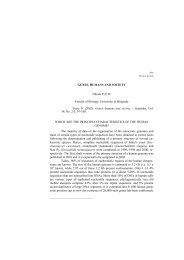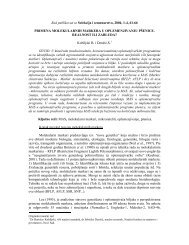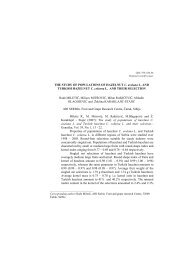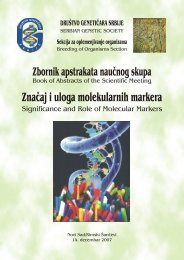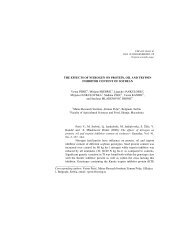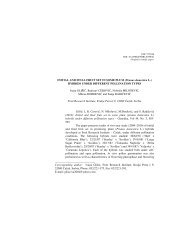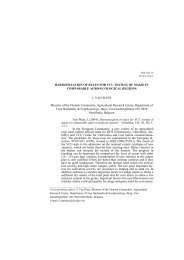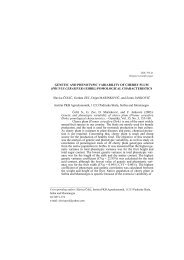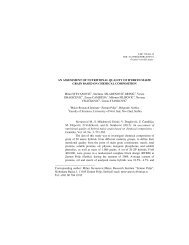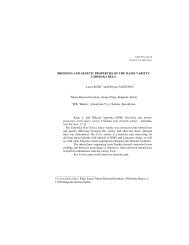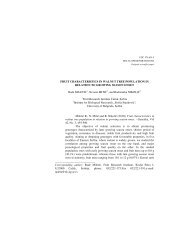Biodiversity of wild fruit species of Serbia
Biodiversity of wild fruit species of Serbia
Biodiversity of wild fruit species of Serbia
Create successful ePaper yourself
Turn your PDF publications into a flip-book with our unique Google optimized e-Paper software.
UDC 575:634.1<br />
DOI: 10.2298/GENSR1201081B<br />
Original scientific paper<br />
BIODIVERSITY OF WILD FRUIT SPECIES OF SERBIA<br />
Dušica BOŠNJAKOVIĆ, Vladislav OGNJANOV, Mirjana LJUBOJEVIĆ, Goran<br />
BARAĆ, Marija PREDOJEVIĆ, Emina MLADENOVIĆ, and Jelena ČUKANOVIĆ<br />
Department <strong>of</strong> Fruit Science, Viticulture, Horticulture and Landscape Architecture<br />
Faculty <strong>of</strong> Agriculture, Novi Sad<br />
Bošnjaković D., V. Ognjanov, M. Ljubojević, G. Barać,<br />
M.Predojević, E. Mladenović and J. Čukanović (2012): <strong>Biodiversity</strong> <strong>of</strong> <strong>wild</strong><br />
<strong>fruit</strong> <strong>species</strong> <strong>of</strong> <strong>Serbia</strong>. - Genetika, Vol 44, No. 1, 81 - 90.<br />
Several field collecting trips in the 2009-2011 period confirmed<br />
that forest <strong>fruit</strong> <strong>species</strong> are an inexhaustible gen<strong>of</strong>ond <strong>of</strong> extremely<br />
important varieties that yield <strong>fruit</strong> <strong>of</strong> excellent quality and high nutritive<br />
value, with wide range <strong>of</strong> applications, including nutritional, medicinal and<br />
food production. The aim <strong>of</strong> this work was to develop long term interactive<br />
and integrated strategy for selection <strong>of</strong> <strong>wild</strong> <strong>fruit</strong> <strong>species</strong> through different<br />
breeding methods, as well as popularization <strong>of</strong> selected products and their<br />
integration into intensive <strong>fruit</strong> growing. The most important morphological,<br />
ecological, and biological characteristics were studied and presented for<br />
____________________________<br />
Corresponding author: Bošnjaković Dušica, Department <strong>of</strong> Fruit Science,<br />
Viticulture, Horticulture and Landscape Architecture, Novi Sad. Trg Dositeja<br />
Obradovića 8., 21000 Novi Sad. email: dusicab@polj.uns.ac.rs
82 GENETIKA, Vol. 44, No.1, 81-90, 2012<br />
Cornus mas, Sambucus nigra, Morus sp. and Rosa sp. For each studied <strong>fruit</strong><br />
<strong>species</strong>, advanced selections for cultivar release has been reported.<br />
Key words: breeding , Cornus mas, Morus sp., Rosa sp., Sambucus<br />
nigra.<br />
INTRODUCTION<br />
Owing to the unique diversity, the Balkan Peninsula could be considered a<br />
secondary center <strong>of</strong> genetic diversity for several <strong>species</strong>, such as Malus × domestica,<br />
Malus sylvestris, Pyrus communis, Prunus cerasifera, Prunus persica, Prunus<br />
mahaleb, Prunus armeniaca, Prunus fruticosa, Prunus amygdalus, Prunus nana,<br />
Morus sp., Juglans regia, Corylus colurna, Corylus avellana, Castanea sativa,<br />
Fragaria vesca, Olea europaea, Cornus mas, Sambucus nigra, Sorbus sp., Rosa sp.<br />
(MRATINIĆ and KOJIĆ, 1998; OGNJANOV et al., 2009). Of particular interest are <strong>wild</strong><br />
<strong>fruit</strong> <strong>species</strong>, due to their excellent quality and high nutritive value <strong>fruit</strong>, used in the<br />
human diet, medicine and in industrial processing.<br />
Cornelian cherry (Cornus mas L.) is a naturally grown <strong>fruit</strong> <strong>species</strong> in<br />
woody regions <strong>of</strong> <strong>Serbia</strong> (OGNJANOV and CEROVIĆ, 2003; BIJELIĆ et al., 2008). It is a<br />
cross-pollinated <strong>species</strong> characterized by wide genetic diversity (NINIĆ-TODOROVIĆ<br />
et al., 2005; BIJELIĆ et al., 2011). Fruits are mainly dark red, cherry red or<br />
occasionally yellow (BIJELIĆ et al., 2008). Cornelian cherry is easy to grow and<br />
tolerant <strong>of</strong> most soils, sites and diseases. Owing to its nutritional, medicinal and<br />
industrial applications, cornelian cherry is a good source <strong>of</strong> dye, oil, tannin and<br />
wood, cornelian cherry is a plant for a healthier future world (GOLOŠIN et al., 2009a,<br />
2009b).<br />
Black elderberry (Sambucus nigra L.) is a high quality <strong>fruit</strong> crop grown on<br />
a small scale in USA and several European countries (CHRISTENSEN et al., 2008).<br />
Historically, its processed <strong>fruit</strong> or flower had wide range <strong>of</strong> applications, both as<br />
medicine and food. However, it was also popular in crafts and ornamental gardening.<br />
MRATINIĆ and FOTIRIĆ (2007) recommended 5 selections from natural population <strong>of</strong><br />
<strong>Serbia</strong> for growing in organic-based production.<br />
In 18 th century, in <strong>Serbia</strong>, mulberry trees were grown for their leaves as<br />
food for silkworms; however, presently, it is predominantly grown for its <strong>fruit</strong>. Three<br />
mulberry <strong>species</strong>, namely black (Morus nigra), red (Morus rubra) and white (Morus<br />
alba), are grown for <strong>fruit</strong> production (SHARMA et al., 2000). Recently, <strong>wild</strong> edible<br />
plants have received much attention as sources <strong>of</strong> biologically active substances<br />
including antioxidants, antimutagens and anticarcinogens (ATMAKURI et al., 2009).<br />
The genus Rosa contains over 100 <strong>species</strong> that are widely distributed in<br />
Europe, Asia, the Middle East and North America. These deciduous shrubs are<br />
widely grown in gardens for their flowers and <strong>fruit</strong>s. The native rose <strong>species</strong> are an<br />
extremely rich source <strong>of</strong> nutrients, in particular, phenolics, carbohydrates, ascorbic<br />
acid and some minerals (ERCISLI, 2007). However, the significant variation in their<br />
content and composition, could be useful for selection <strong>of</strong> relevant <strong>species</strong> or<br />
genotypes in future plant-breeding studies (DAVIS, 1997). In general, rose hips are
D. BOSNJAKOVIC et al.: BIODIVERSITY OF WILD FRUIT SPECIES 83<br />
used in the food industry to obtain different products, such as tea, jam, jelly and<br />
marmalade.<br />
The objective <strong>of</strong> the work presented here was to collect, evaluate, conserve<br />
and promote <strong>wild</strong> <strong>fruit</strong> germplasm <strong>of</strong> <strong>Serbia</strong> as a <strong>fruit</strong> plant for the future and make it<br />
available to breeding programs, fresh consumption and food industry.<br />
MATERIALS AND METHODS<br />
During the systematic exploration trips conducted over the three-year<br />
period, accessions were collected over wide areas <strong>of</strong> <strong>Serbia</strong> (Fig.1), whereby local<br />
collaborators pointed out valuable <strong>wild</strong> <strong>fruit</strong> <strong>species</strong> germplasm available under both<br />
natural and managed habitats. Some <strong>of</strong> these areas have extreme climatic conditions<br />
and are effectively isolated.<br />
Figure 1. Exploration trip locations included in the selection <strong>of</strong> <strong>wild</strong> <strong>fruit</strong> <strong>species</strong><br />
All the accessions were evaluated and conserved in situ, ex situ and in vitro.<br />
The passport data were permanently determined with GPS method. Our germplasm<br />
collecting missions may be broadly categorized into <strong>species</strong>-specific or trait-specific,<br />
rather than broad-based or non-specific that relies on random sampling in order to<br />
collect maximum diversity <strong>of</strong> the <strong>species</strong> and relatives in a single trip. The<br />
evaluation and characterization <strong>of</strong> individual accessions was conducted based on<br />
following features: yield, <strong>fruit</strong> size, flesh/stone ratio, skin color, flesh color, dry
84 GENETIKA, Vol. 44, No.1, 81-90, 2012<br />
matter, taste and aroma. Special attention was paid to the disease resistance <strong>of</strong><br />
selected accessions making them suitable for organic or integrated <strong>fruit</strong> production.<br />
Statistical analysis included Duncan multiple range tests. Results were processed<br />
using STATISTICA 10 s<strong>of</strong>tware (StatS<strong>of</strong>t, Inc., Tulsa, OK, USA).<br />
RESULTS AND DISCUSSION<br />
An extensive field and laboratory characterization <strong>of</strong> the germplasm materials<br />
was undertaken on all important agro-morphological parameters.<br />
Cornelian cherry (Cornus mas L.)<br />
Average population <strong>fruit</strong> weight based on 8 selections, was 4.34 g, ranging<br />
from 1.52 to 14.55 g, <strong>of</strong> which, on average stone weighed 0.51 g. Fruit was <strong>of</strong><br />
oblong shape, red to dark red in color, with total soluble solids up to 23.74%. All<br />
selections were late maturing with ripening season from August 17 th to September<br />
20 th (Tab.1). Selected material represents a wealth <strong>of</strong> biological and economic<br />
potential, as well as a rich source <strong>of</strong> material for further breeding.<br />
Table 1. Pomological characteristic <strong>of</strong> Cornus mas selections<br />
Genotype<br />
Ripening<br />
time<br />
Weight<br />
(g)<br />
Skin<br />
color<br />
Loboderac 25. Aug 3.51 b* Dark<br />
red<br />
VR 10 25. Aug 14.55 a<br />
Srem 29. Aug 3.55 b<br />
D1 29. Aug 3.96 b<br />
D2 26. Aug 4.10 b<br />
TS 5 20. Sep 1.52 c<br />
TS 3 30. Aug 1.56 c Light<br />
red<br />
TS 1 17. Aug 1.94 c Dark<br />
red<br />
Flesh<br />
color<br />
Dry matter<br />
(%)<br />
Red 17.52 b<br />
Red Red 12.90 c<br />
Stone<br />
weight<br />
(g)<br />
0.58 a<br />
0.60 a<br />
Red Red 18.94 b 0.52 ab<br />
Red Yellow 18.86 b<br />
Red Yellow 17.34 b<br />
Red Red 19.26 b<br />
Red 20.16 b<br />
Pink 23.74 a<br />
* Significance <strong>of</strong> differences was tested by Duncan multiple range test (p
D. BOSNJAKOVIC et al.: BIODIVERSITY OF WILD FRUIT SPECIES 85<br />
Elderberry (Sambucus nigra)<br />
The largest inflorescences were found in genotype ZLJ with maximum weight<br />
exceeding 350 g. Ripening period ranged from August 15 th to 25 th . Average<br />
inflorescence and 10 berries weighed 64.95 - 241.52 g and 1.11 - 7.72 g,<br />
respectively. Best <strong>fruit</strong> quality was observed in ZLJ due to highest content <strong>of</strong> colored<br />
matter, dark red colored juice, and 15.14% <strong>of</strong> dry matter (Tab.2). However,<br />
genotypes Z23 and Z24, selected from Horgoš, had better set <strong>of</strong> morphological traits<br />
compared to standard variety “Haschberg”.<br />
Table 2. Pomological characteristic <strong>of</strong> Sambucus nigra selections<br />
Genotype Ripening<br />
time<br />
Inflorescence<br />
weight (g)<br />
Haschberg 25. Aug 121.32 bc*<br />
ZBV 25. Aug 64.95 d<br />
ZB 15. Aug 127.03 bc<br />
Z23 25. Aug 169.50 b<br />
Z24 25. Aug 134.95 bc<br />
ZPl 19. Aug 99.95 cd<br />
ZLJ 19. Aug 241.52 a<br />
ZB2 19. Aug 129.90 bc<br />
ZB3 19. Aug 75.56 cd<br />
10 berry<br />
weight<br />
(g)<br />
1.77 bc<br />
1.11 cd<br />
1.72 bc<br />
1.37 cd<br />
1.90 b<br />
1.21 d<br />
7.72 a<br />
1.19 d<br />
1.80 b<br />
Juice<br />
color<br />
* Significance <strong>of</strong> differences was tested by Duncan multiple range test (p
86 GENETIKA, Vol. 44, No.1, 81-90, 2012<br />
mulberry accessions, with <strong>fruit</strong> ranging from cream to dark color. M. rubra accession<br />
ripened at the same time as M. alba, with its ripening season extended by a month<br />
after the latest M. alba matured (Tab.3).<br />
Table 3. Pomological characteristic <strong>of</strong> Rosa sp. selections<br />
Genotype<br />
R.canina<br />
Inermis<br />
R. dumetorum<br />
Laxa<br />
R. canina<br />
Polmeriana<br />
Ripening<br />
time<br />
10. Sep<br />
Fruit<br />
shape<br />
Very<br />
elongate<br />
Weight<br />
(g)<br />
15. Sep Elongate 2.39 a<br />
1. Oct Cordate 2.62 a<br />
ŠTS1 1. Sep Elongate 2.12 ab<br />
ŠD1 1. Sep Elongate 1.72 b<br />
Š1 TS 1. Sep Elongate 2.40 a<br />
Seed<br />
number<br />
2.48 a* 28 c<br />
30 c<br />
40 a<br />
38 ab<br />
31 bc<br />
* Significance <strong>of</strong> differences was tested by Duncan multiple range test (p
D. BOSNJAKOVIC et al.: BIODIVERSITY OF WILD FRUIT SPECIES 87<br />
Pre-exploration review focused on gathering prior knowledge <strong>of</strong> the<br />
topography, eco-habitats and <strong>species</strong> occurring as semi-cultivated, semi-<strong>wild</strong> or <strong>wild</strong>,<br />
as well as associated <strong>species</strong> in the area and specific diversity to look for. In<br />
addition, the terrain accessibility, information on previous surveys and collecting<br />
trips made in the area and their results, as well as established local<br />
contacts/networks, was also sought. The nature <strong>of</strong> <strong>species</strong> diversity and its spatial<br />
occurrence was mapped, followed by the implementation <strong>of</strong> method <strong>of</strong> individual<br />
selection from local natural populations. Applied selection strategy resulted in<br />
tremendous progress in genetic gain and diversity, such as VR10 and Loboderac in<br />
cornelian cherry, ZLJ, Z23 and Z24 in elderberry and MR1 and ŽP2 in mulberry. All<br />
collected accessions were regenerated and inventoried in order to be entered into the<br />
referent collection for future distinctiveness, uniformity and stability (DUS) tests.<br />
The collected <strong>fruit</strong>s were dried or frozen and subsequently processed in traditional<br />
ways for further biochemical analysis <strong>of</strong> their nutritional and medicinal values. That<br />
part <strong>of</strong> research was enabled by the frequent interactions and discussions with the<br />
local villagers, who shared their knowledge on traditional uses <strong>of</strong> <strong>wild</strong> edible <strong>fruit</strong>s.<br />
Table 4. Pomological characteristic <strong>of</strong> Morus sp. selections<br />
Genotype Ripening time Fruit color Weight<br />
(g)<br />
Dry matter<br />
(%)<br />
PB1 15. June Dark<br />
purple<br />
5.00 ab* 14.48 cde<br />
DT1 10. June Black 1.40 d<br />
19.08 b<br />
MG 1 12. June Pink-purple 3.73 bc<br />
16.66 bc<br />
ŽD 1 10. June Multicolor 2.90 c 24.56 a<br />
JP 2 10. June Black 1.87 d<br />
16.08 bc<br />
MR 1 15. June Pink-purple 5.05 ab<br />
19.68 b<br />
DJ 1 12. June White 5.85 a<br />
15.12 cd<br />
ŽP 1 12. June White 5.87 a<br />
13.40 de<br />
ŽP 2 12. June Multicolor 4.82 ab<br />
13.10 de<br />
ŽP 3 12. June Black 1.87 d<br />
13.20 de<br />
BP 1/4 10. June Black 3.87 bc<br />
13.98 cde<br />
BP 3/9 12. June White 3.67 bc<br />
16.92 bc<br />
ŽP 1/5 12. June White 3.08 bcd<br />
19.64 b<br />
PK 10. June Black 2.62 bc 15.54 cd<br />
MN 1 10. June Black 2.95 bc<br />
FR 10. June Black 3.18 bcd<br />
* Significance <strong>of</strong> differences was tested by Duncan multiple range test (p
88 GENETIKA, Vol. 44, No.1, 81-90, 2012<br />
CONCLUSION<br />
Forest ecosystems cover a vast territory in <strong>Serbia</strong>. Among the several<br />
hundred forest <strong>species</strong>, <strong>fruit</strong> <strong>species</strong>, <strong>of</strong> which there are over 100, attract special<br />
attention. The information generated from this study is another pro<strong>of</strong> that The<br />
Balkan Peninsula is one <strong>of</strong> the world's richest and inexhaustible secondary centers <strong>of</strong><br />
<strong>wild</strong> <strong>fruit</strong> <strong>species</strong> diversity. Our extensive work in identifying the areas most<br />
abundant in <strong>wild</strong> <strong>fruit</strong> <strong>species</strong> included subjecting several selections—VR10 and<br />
Loboderac in cornelian cherry; ZLJ, Z23 and Z24 in black elderberry; MR1 and ŽP2<br />
in mulberry—to immediate in-depth research. The aim <strong>of</strong> this effort was to achieve<br />
advanced selection for cultivar release, based on specific pomological, agronomical,<br />
and biochemical traits, <strong>of</strong> particular interest in finding new sources for natural<br />
antioxidants, traditional utilization and processing as functional food that provides<br />
health and medical benefits.<br />
Received October 27 th , 2011<br />
Accepted February 23 rd , 2012<br />
REFERENCES<br />
ATMAKURI, R.A., R. CHAUDHURY, S.K. MALIK, S. KUMAR, R.RAMACHUNDLAN, H.M.S.QADRI, (2009):<br />
Mulberry biodiversity conservation through cryopreservation. In vitro Cell Dev-Pl. 45: 639-<br />
640.<br />
BIJELIĆ, S., J. NINIĆ-TODOROVIĆ, B. GOLOŠIN, S. CEROVIĆ, V. OGNJANOV, (2008): Selections <strong>of</strong> Cornelian<br />
Cherry (Cornus mas L.) at the Faculty <strong>of</strong> Agriculture <strong>of</strong> Novi Sad. Proceedings. 43rd Croatian<br />
and 3rd International Symposium on Agriculture. Opatija. Croatia. 901-904.<br />
BIJELIĆ, S., B. GOLOŠIN, J. NINIĆ-TODOROVIĆ, S.CEROVIĆ, (2011): Morphological characteristics <strong>of</strong> best<br />
Cornelian cherry (Cornus mas L.) genotypes selected in <strong>Serbia</strong>. Genet. Resour. Crop. Ev. 58<br />
(5), 689-695.<br />
CHRISTENSEN, P.L., K. KAACK, C.X. FRETTE, (2008): Selection <strong>of</strong> elderberry (Sambucus nigra L.)<br />
genotypes best suited for the preparation <strong>of</strong> elderflower extracts rich in flavonoids and<br />
phenolic acids. Eur. Food Res. Technol. 227, 293-305.<br />
DAVIS, P.H. (1997): Flora <strong>of</strong> Turkey and the East Aegean Islands, Edinburgh University Press, Edinburgh.<br />
ERCISLI, S. (2007): Chemical composition <strong>of</strong> <strong>fruit</strong>s in some rose (Rosa spp.) <strong>species</strong>. Food Chem. 104 (4),<br />
1379-1384.<br />
GOLOŠIN, B., S. BIJELIĆ, J. TODOROVIĆ-NINIĆ, V.OGNJANOV, (2009a): Fruit Nutritional Value <strong>of</strong> Cornelian<br />
Cherry (Cornus mas L.) Genotypes Selected in the Vojvodina in: InterRegioSci, The forth<br />
scientific-technical meeting, The book <strong>of</strong> abstracts, Novi Sad: Faculty <strong>of</strong> Agriculture, p. 26.<br />
GOLOŠIN, B., S. CEROVIĆ, J. TODOROVIĆ-NINIĆ, V. OGNJANOV,S. BIJELIĆ, (2009b): Cornelian Cherry<br />
(Cornus mas L.) Breeding for Organic Fruit Production in Vojvodina in: InterRegioSci, The<br />
forth scientific-technical meeting, The book <strong>of</strong> abstracts,Novi Sad:Faculty <strong>of</strong> Agriculture, p.<br />
35.<br />
MRATINIĆ, E., M. KOJIĆ, (1998): Wild <strong>fruit</strong> <strong>species</strong> <strong>of</strong> <strong>Serbia</strong>. Agricultural Research Institute <strong>of</strong> <strong>Serbia</strong>,<br />
Belgrade.<br />
MRATINIĆ, E., M.FOTIRIĆ, (2007): Selection <strong>of</strong> black elderberry (Sambucus nigra L.) and evaluation <strong>of</strong> its<br />
<strong>fruit</strong>s usability as biologically valuable food. Genetics, 39 (3), 305-314.
D. BOSNJAKOVIC et al.: BIODIVERSITY OF WILD FRUIT SPECIES 89<br />
OGNJANOV, V., S.CEROVIĆ, ( 2003): Selection and utilization <strong>of</strong> Minor Fruit Tree Species. Eucarpia<br />
symposium on <strong>fruit</strong> breeding and genetics, Angers. Acta Hortic, 663, 569-574.<br />
OGNJANOV, V., Z. KESEROVIĆ, E. MRATINIĆ, R.MILETIĆ, (2009): Fruit Germpasm in <strong>Serbia</strong>. Proceedings <strong>of</strong><br />
the Scientific Meeting on the Management <strong>of</strong> Genetic Resources <strong>of</strong> Plant and Animal Species<br />
in <strong>Serbia</strong>. Belgrade, 89-99.<br />
SHARMA, A., R. SHARMA, H.MACHII, (2000): Assessment <strong>of</strong> genetic diversity in a Morus germplasm<br />
collection using fluorescence-based AFLP markers. Theor. Appl. Genet. 101 (7), 1049-1055.<br />
NINIĆ-TODOROVIĆ, J., S. CEROVIĆ, B. GOLOŠIN, S. BIJELIĆ, R. MILETIĆ,(2005): Selection <strong>of</strong> Cornelian<br />
Cherry (Cornus mas L.). J. <strong>of</strong> Pomology, 152, 395-399.
90 GENETIKA, Vol. 44, No.1, 81-90, 2012<br />
BIODIVERZITET SAMONIKLIH VOĆNIH VRSTA SRBIJE<br />
Dušica BOŠNJAKOVIĆ, Vladislav OGNJANOV, Mirjana LJUBOJEVIĆ, Goran<br />
BARAĆ, Marija PREDOJEVIĆ, Emina MLADENOVIĆ, i Jelena ČUKANOVIĆ<br />
Departman za voćarstvo, vinogradarstvo, hortikulturu i pejzažnu arhitekturu<br />
Poljoprivredni fakultet, Novi Sad<br />
I z v o d<br />
Oplemenjivački rad na očuvanju genetičkih resursa u periodu 2009-2011. potvrdio je<br />
da su šumske voćne vrste neiscrpan gen<strong>of</strong>ond koje daju plodove izuzetnog kvaliteta i<br />
visoke nutritivne vrednosti sa važnom ulogom u ljudskoj ishrani, i velikim<br />
mogućnostima prerade i primene u medicini. Cilj istraživanja je bio razvijanje<br />
dugoročnog multidisciplinarnog pristupa selekciji samoniklih voćnih vrsta kroz<br />
razne metode oplemenjivanja, kao i popularizacija izabranih selekcija i njihovo<br />
uvođenje u intenzivne zasade. Izučavane su najvažnije morfološke, ekološke i<br />
biološke karakteristike vrsta Cornus mas, Sambucus nigra, Morus sp. i Rosa sp. Kod<br />
svake izučavane voćne vrste izdvojena je jedna ili više perspektivnih selekcija kao<br />
potencijalno novih sorti samoniklih voćnih vrsta u Srbiji.<br />
Primljeno 27. X. 2011.<br />
Odobreno 23. II. 2012.



